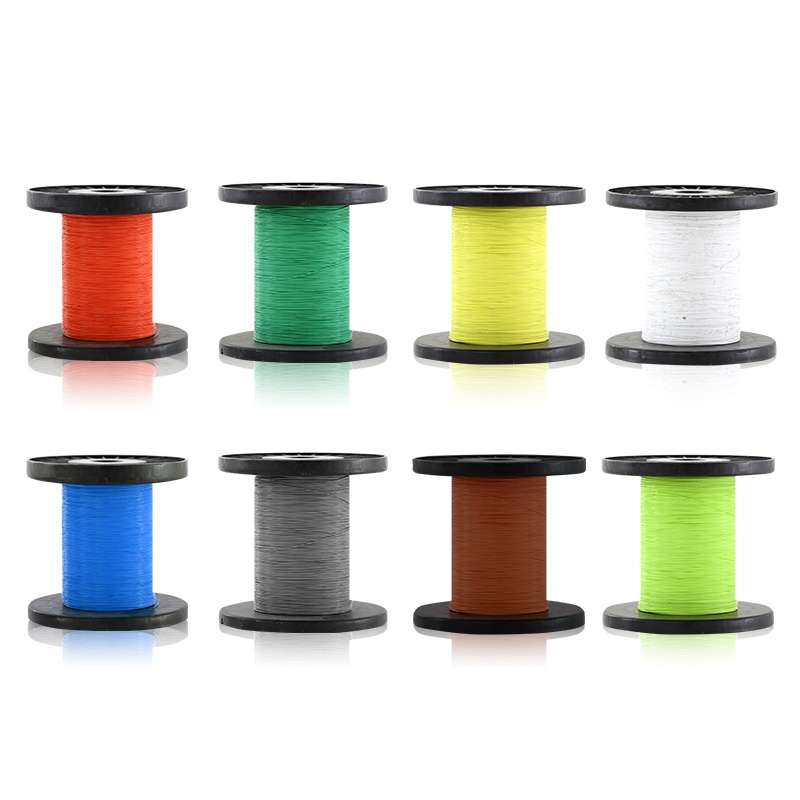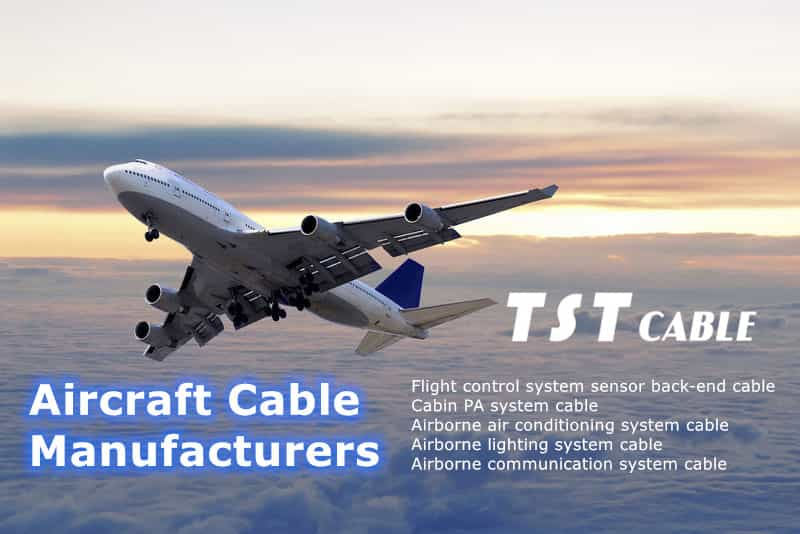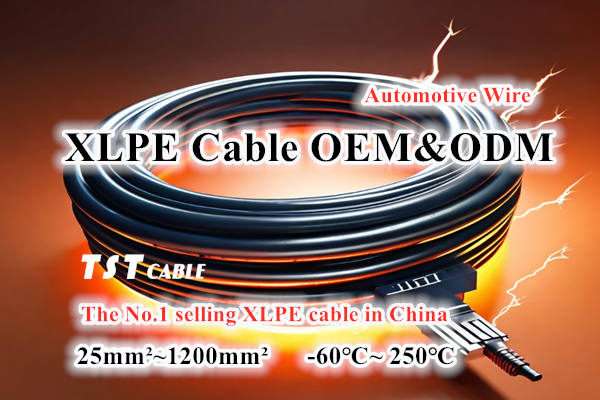PE cable (polyethylene), PVC cable (polyvinyl chloride), and XLPE cable (cross-linked polyethylene) are three common cable insulation materials, each with its own characteristics in terms of performance, applicable environment, and application occasions. TST CABLES will give you a detailed introduction to the main differences and applications of these three materials. You can choose the most suitable cable insulation material according to your specific needs by understanding the characteristics of these materials to ensure the efficient operation and safety of the equipment system.

1. PE cable (polyethylene)
Temperature range: PE is suitable for medium temperature ranges, and the general operating temperature is -40°C to 70°C.
Mechanical properties: PE has good flexibility and tear strength, but its wear resistance is relatively weak.
Electrical properties: PE has a low dielectric constant and a small capacitance effect, is suitable for high-frequency signal transmission, and has excellent electrical insulation properties.
Chemical stability: PE has good resistance to most chemicals, but may dissolve in some solvents.
Cost: PE is a relatively economical material with low cost.
Environmental protection: PE produces less smoke and low toxicity when burned, and meets modern environmental protection standards.
2. PVC cable(Polyvinyl Chloride)
Temperature Range: PVC is suitable for a lower operating temperature range, generally -10°C to 70°C, and some modified PVC can reach 90°C.
Mechanical Properties: PVC has good flexibility and wear resistance, but relatively poor heat resistance and anti-aging properties.
Electrical Properties: PVC has a high dielectric constant, resulting in a large capacitance effect, which may affect signal transmission.
Chemical Stability: PVC has a certain resistance to most chemicals, but is easily dissolved in some solvents.
Cost: PVC is an economical material with a relatively low cost.
Environmental Protection: PVC releases harmful gases such as hydrogen chloride when burned, so there are certain problems in environmental protection.
3. XLPE cable(Cross-linked Polyethylene)
Temperature Range: XLPE is suitable for a higher operating temperature range, generally -40°C to 90°C, and some special models can even reach 125°C.
Mechanical Properties: XLPE has excellent mechanical strength and wear resistance, is not easy to crack, and can maintain good physical properties at high temperatures.
Electrical properties: XLPE has a low dielectric constant and small capacitance effect, is suitable for high-frequency signal transmission, and has excellent electrical insulation properties.
Chemical stability: XLPE has good resistance to most chemicals, including oils and solvents.
Cost: The cost of XLPE is slightly higher than PE and PVC, but its high performance makes it more competitive in many applications.
Environmental protection: XLPE produces less smoke and less toxicity when burned, which meets modern environmental protection standards.

PE cable PVC cable XLPE cable performance comparison
| Features | PE (Polyethylene)cable | PVC (Polyvinyl Chloride)cable | XLPE (Cross-Linked Polyethylene)cable |
| Temperature range | -40°C to 70°C | -10°C to 70°C (up to 90°C) | -40°C to 90°C (up to 125°C) |
| Mechanical properties | Good flexibility, strong tear resistance | Good flexibility and strong wear resistance | High mechanical strength, wear resistance, not easy to crack |
| Electrical properties | Low dielectric constant, small capacitance effect | High dielectric constant and large capacitance effect | Low dielectric constant, small capacitance effect |
| Chemical stability | Good resistance to most chemicals | Resistant to most chemicals | Good resistance to most chemicals |
| Cost | Economical, low cost | Economical and low cost | Slightly higher cost |
| Environmental protection | Low smoke and low toxicity when burning | Releases harmful gases when burned | Low smoke and low toxicity when burning |
Application Selection
PE: Suitable for applications such as medium and low voltage power transmission, communication cables, agricultural irrigation systems, etc. that require good electrical insulation and low temperature performance.
PVC: Suitable for applications that are cost-sensitive, have low temperature requirements and require a certain degree of flexibility, such as household electricity, commercial buildings, etc.
XLPE: Suitable for high voltage power transmission, aerospace, industrial control and other fields, especially for applications that require high temperature, high reliability and good electrical performance.
Next, TST CABLES will further explore the characteristics of PE, PVC and XLPE cable insulation materials and their selection in different application scenarios, as well as some actual application cases.
4. Performance Comparison
Heat Resistance
PE: Polyethylene (PE) is suitable for medium temperature ranges, generally -40°C to 70°C. Its low temperature brittleness is low, but the mechanical properties will decrease at high temperatures.
PVC: Polyvinyl chloride (PVC) is suitable for lower temperature ranges, generally -10°C to 70°C. Some modified PVC can withstand higher temperatures (up to 90°C), but long-term high temperatures will cause material aging.
XLPE: Cross-linked polyethylene (XLPE) has excellent high temperature resistance and can work stably in the range of -40°C to 90°C. Special models can even withstand temperatures up to 125°C. The cross-linked structure improves the thermal stability of the material.
Electrical properties
PE: PE has a low dielectric constant (about 2.3) and a small capacitance effect, which is suitable for high-frequency signal transmission. It also has excellent electrical insulation properties and is widely used in power transmission and communication fields.
PVC: PVC has a high dielectric constant (about 6.0) and a large capacitance effect, which may affect the quality of high-frequency signals. Therefore, PVC is more used in low-frequency or medium-frequency applications.
XLPE: XLPE has a low dielectric constant (about 2.5) and a small capacitance effect, which is suitable for high-frequency signal transmission. In addition, XLPE has a high breakdown strength, making it an ideal choice for high-voltage cables.
Mechanical properties
PE: PE has good flexibility and tear resistance, but is not as good as XLPE in abrasion resistance and tensile strength.
PVC: PVC has good flexibility and abrasion resistance, but it is easy to soften at high temperatures, and its tensile strength and impact resistance are relatively weak.
XLPE: After cross-linking, the mechanical strength of XLPE is significantly improved, and it has excellent tensile, impact and wear resistance, which is particularly suitable for applications that require high strength.
Chemical stability
PE: It has good resistance to most chemicals, but may dissolve in some organic solvents.
PVC: It has a certain resistance to many chemicals, but performs poorly in strong acids, strong alkalis and some organic solvents.
XLPE: It has good resistance to most chemicals, especially oils and solvents, and is suitable for the chemical and petroleum industries.
Environmental protection
PE: It produces less smoke and less toxicity when burning, which meets modern environmental protection standards.
PVC: It releases harmful gases (such as hydrogen chloride) when burning, and is less environmentally friendly.
XLPE: It produces less smoke and less toxicity when burning, which meets modern environmental protection standards.
5. Application scenarios and selection suggestions
PE cable
Applicable scenarios:
Medium and low voltage power transmission
Communication cable
Agricultural irrigation system
Household electricity (such as wires)
Selection reasons:
Low cost, economical
Good electrical insulation performance, suitable for high frequency signal transmission
Good environmental protection
PVC cable
Applicable scenarios:
Internal wiring of home and commercial buildings
Control cable
Temporary power line
Occasions with low cost requirements
Selection reasons:
Low cost
Good flexibility, easy to install
Applicable to environments with low temperature requirements
XLPE cable
Applicable scenarios:
High voltage power transmission
Aerospace equipment
Industrial automation control system
Application in high temperature environment
Submarine cable
Selection reasons:
Excellent high temperature performance
High mechanical strength and strong durability
Superior electrical performance, suitable for high frequency signal transmission
Good environmental protection
6. Actual application cases
PE cable
Agricultural irrigation system: PE cable is widely used in power transmission of agricultural irrigation system due to its good electrical insulation performance and cost advantage, ensuring the reliability and safety of the system.
Household electricity: PE cables are often used for internal wiring in homes, especially in situations where good electrical insulation and environmental performance are required.
PVC cables
Interior wiring in commercial buildings: PVC cables are a common choice for internal wiring in commercial buildings due to their flexibility and economy, especially in cost-sensitive and temperature-insensitive environments.
Control cables: PVC cables are also widely used in industrial control cables, providing good mechanical protection and certain electrical performance.
XLPE cables
Submarine cables: XLPE cables are widely used in submarine cable projects due to their excellent electrical performance and mechanical strength, ensuring the reliability of long-distance power transmission.
Aerospace equipment: XLPE cables are essential in aerospace equipment, and their high-temperature performance and lightweight design meet the strict weight and performance requirements of aircraft.
High-voltage transmission lines: XLPE cables perform well in high-voltage transmission lines, and their low dielectric constant and high breakdown strength ensure the safety and efficiency of power transmission.
7. Future trends
With the advancement of technology and changes in market demand, cable insulation materials are also constantly evolving. In the future, we may see more applications of high-performance, environmentally friendly materials, such as:
New cross-linked materials: Develop higher-performance cross-linked materials to improve the temperature resistance and mechanical strength of cables.
Smart cables: Smart cables with integrated sensors and self-diagnosis functions will be able to monitor cable status in real time and improve maintenance efficiency.
Environmentally friendly materials: Develop more low-smoke, halogen-free, flame-retardant and environmentally friendly materials to meet increasingly stringent environmental protection requirements.
Selecting the right cable insulation material requires comprehensive consideration of multiple factors, including operating temperature, mechanical stress, electrical properties, chemical environment and cost. PE cables, PVC cables and XLPE cables each have their own unique advantages and applicable scenarios. Reasonable selection can ensure the efficient operation and safety of the system. I hope this information can help you better understand and choose cable insulation materials. If you have other questions or need further help, please feel free to contact TST CABLES cable engineers by email to get free solutions and samples.
Also available in:
Arabic
English
Japanese
Russian
Portuguese (Brazil)





